|
|
|
Sort Order |
|
|
|
Items / Page
|
|
|
|
|
|
|
| Srl | Item |
| 1 |
ID:
139127
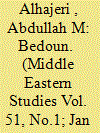

|
|
|
|
|
| Summary/Abstract |
The Bedoun (stateless/without nationality) in Kuwait constitute a controversial concurrent social, political and legal issue, which was and still is the subject of heated political debate, a vivid example of social conflict, and a platform of extensive legal deliberation concerning its thorny dimensions. The problem of Bedoun is not only politically and socially complex, but it has its problematic legal dimensions, which have made it, since the 1950s, a complex and chronic problem. The recent growing interest in addressing the issue and the extensive strife to determine its degree of complexity and entanglement could be ascribed to the margin of freedom enjoyed in Kuwait more than the rest of the Arabian Gulf states, since active social and political participation constitute the pillars of the democratic system in Kuwait, in light of the growing political and media freedoms and the focus on the Bedoun as a marginalized community legally, politically and socially. Therefore, the current problem ofBedoun constitutes the strongest internal concern for the Kuwaiti authorities and people after the external threats, especially because it has always been ignored or treated as a security issue at times. This study seeks to shed light on the issue of Bedoun to decipher its causes and its historical development until it became a pressing issue at government and community levels in the State of Kuwait. The study will avoid the complex legal and social complexities of the issue.
|
|
|
|
|
|
|
|
|
|
|
|
|
|
|
|
| 2 |
ID:
145799
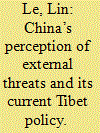

|
|
|
|
|
| Summary/Abstract |
Little thought has been given to the possibility that China’s repressive Tibet policy could be driven largely by its fear of external forces, as opposed to the government’s authoritarian nature. This article tries to explain why it was only in 1994 that Chinese authorities seriously and systematically strengthened religious control in Tibet. This had been put in place during the 1987–89 protests but never effectively enforced. The key is the Chinese leaders’ perception of external threats in the post-Tiananmen era, which prompted Chinese authorities to believe that instead of being mostly an ethnic nuisance, Tibetan separatism—utilizing Tibetan Buddhism as a “weapon”—had become a “tool” wielded by “hostile Western forces” seeking ultimately to break up China.
|
|
|
|
|
|
|
|
|
|
|
|
|
|
|
|
| 3 |
ID:
188775
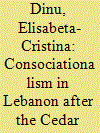

|
|
|
|
|
| Summary/Abstract |
The literature on consociationalism posits external threats increase elite cooperation and political stability in consociational systems, provided that the threat is perceived as common by all political segments. Lebanon—a prominent consociational case—invites further reflection on this proposition, as international crises and even war did not increase cooperation between political parties. To further explore the relationship between external threats and political stability, the paper proposes a critical security approach, based on the Copenhagen School of security. The study investigates how political elites construct foreign threats relying on media analysis complemented by personal elite and expert interviews, as well as secondary sources. The study finds that despite political elites’ commitment to system maintenance, external threats decrease political stability in Lebanon because political segments are part of competing macrosecuritizations.
|
|
|
|
|
|
|
|
|
|
|
|
|
|
|
|
| 4 |
ID:
149747


|
|
|
|
|
| Summary/Abstract |
A relative oasis of stability in a troubled region, Jordan is nonetheless contending with multiple internal pressures that could yet destabilise it. Mohammed Najib surveys the security challenges facing the kingdom following the 20 September elections.
|
|
|
|
|
|
|
|
|
|
|
|
|
|
|
|
| 5 |
ID:
146990


|
|
|
|
|
| Publication |
New Delhi, Pentagon Press (IDSA), 2016.
|
| Description |
x, 192p.: tables, chartshbk
|
| Standard Number |
9788182749191
|
|
|
|
|
|
|
|
|
|
|
|
Copies: C:2/I:0,R:0,Q:0
Circulation
| Accession# | Call# | Current Location | Status | Policy | Location |
| 058766 | 355.033054/CHA 058766 | Main | On Shelf | General | |
| 058767 | 355.033054/CHA 058767 | Main | On Shelf | General | |
|
|
|
|
| 6 |
ID:
108600
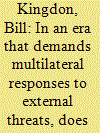

|
|
|
| 7 |
ID:
158834
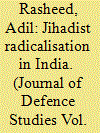

|
|
|
|
|
| Summary/Abstract |
The Indian strategic community has for long debated aspects of jihadist radicalisation in the country—particularly over its origins, causes, extent, trajectory and possible counter-measures. This article posits that in the absence of clear perspectives, the incipient threat of jihadist radicalisation has the potential to metastasise and snowball quickly, as has been witnessed in other parts of the world in recent times. Currently, there are three strands of jihadist radicalisation seeking to influence Indian minds, namely, homegrown radicalisation, cross-border radicalisation and the global jihadist radicalisation of transnational groups like al-Qaeda and the Islamic State of Iraq and Syria (ISIS). Although all the three forms have different strategic orientation and goals, they often collude to administer a heady brew to impressionable minds vexed by the country’s several socio-cultural, economic and political challenges.
|
|
|
|
|
|
|
|
|
|
|
|
|
|
|
|
| 8 |
ID:
139216
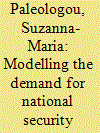

|
|
|
|
|
| Summary/Abstract |
In the past, national security for the majority of countries was almost exclusively associated with an external military threat emanating from a rival state(s). This was reflected in the standard models for the demand for military expenditure. The emergence of new security challenges such as terrorism, transnational crime networks, failed and rogue states, has profoundly affected the international security environment and the concept of national security. This note develops a model for the demand for national security expenditure adopting a broader, more inclusive definition of national security and includes concomitant budgetary outlets to meet the new security challenges.
|
|
|
|
|
|
|
|
|
|
|
|
|
|
|
|
| 9 |
ID:
124525
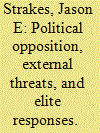

|
|
|
|
|
| Publication |
2013.
|
| Summary/Abstract |
In the years since the 2003 Rose Revolution, the popularly elected leadership of the Republic of Georgia has responded to organized protests with a variety of repressive tactics. These reactions suggest that former challengers to authoritarian elites may utilize similar methods of retaining power during crisis periods. Yet, the alleged involvement of agencies of the Russian Federation in fomenting domestic instability has also occupied a central position in the national security policies of the outgoing Saakashvili government. These conditions both preceded and were reinforced by the South Ossetia War of August 2008. This article proposes a theoretical model that represents the intervening effect of interstate conflicts on state-society relations in Georgia from 2003 to present. It presents several hypotheses and possible indicators, data sources, and techniques for analyzing the interaction between characteristics of opposition groups, external threats, and the domestic security practices of contemporary Georgian political elites.
|
|
|
|
|
|
|
|
|
|
|
|
|
|
|
|
| 10 |
ID:
087597
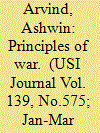

|
|
|
|
|
| Publication |
2009.
|
| Summary/Abstract |
This paper endeavours to collate all the enunciated principles of war. It examines their relevance across the dimensions and spectrum of conflict that the country is likely to face and suggests a set of principles that would the test in future.
|
|
|
|
|
|
|
|
|
|
|
|
|
|
|
|
| 11 |
ID:
074762
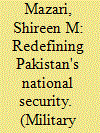

|
|
|
| 12 |
ID:
152142
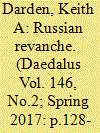

|
|
|
|
|
| Summary/Abstract |
Has the development of post-Soviet Russia in an international system dominated by a democracy-promoting United States bred an authoritarian reaction in Russia as a response to perceived threats from the West? Beginning with the NATO bombing of Yugoslavia in 1999, Russian elites have increasingly seen the United States as a distinctively threatening power, one with a strategy to exploit civic organizations, ethnic groups, and other forms of domestic pluralism as “fifth columns” in an effort to overthrow unfriendly regimes. With each new crisis in U.S.-Russian relations – Ukraine 2004, Georgia 2008, Ukraine 2014 – the Russian leadership has tightened controls over society, the press, and the state. The result is that the United States’ muscular promotion of democracy abroad has produced the opposite of its intended effect on Russia, leading successive Russian governments to balance the perceived threat from the United States by pursuing greater military and intelligence capacity to intervene abroad, and by tightening internal authoritarian controls at home to prevent foreign exploitation of the nascent internal pluralism that emerged in the wake of Communism.
|
|
|
|
|
|
|
|
|
|
|
|
|
|
|
|
| 13 |
ID:
191907
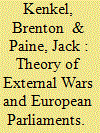

|
|
|
|
|
| Summary/Abstract |
The development of parliamentary constraints on the executive was critical in Western European political history. Previous scholarship identifies external wars as a key factor, but with varying effects. Sometimes, willing monarchs granted parliamentary rights in return for revenues to fight wars. Yet at other times, war threats empowered rulers over other elites or caused states to fragment. We analyze a formal model to understand how external wars can either stimulate or undermine prospects for a contractual relationship between a ruler and elite actors. We recover the standard intuition that war threats make the ruler more willing to grant parliamentary rights in return for revenue. Our key insight is that war threats also affect the bargaining position of elites. A previously unrecognized tension yields our new findings: stronger outsider threats increase pressure either on elites to fund the ruler or on the ruler to accept constraints—but not both simultaneously. Elites with immobile wealth depend on the ruler for security. War threats undercut their credibility to refuse funding for an unconstrained ruler. By contrast, war threats make elites with mobile wealth and a viable exit option unwilling to fund a hopeless war effort. Only under circumscribed conditions do war threats align three conditions needed for parliament to arise in equilibrium: ruler willingness, elite credibility, and elite willingness. We apply our theory to posit strategic foundations for waves and reversals of historical European parliaments.
|
|
|
|
|
|
|
|
|
|
|
|
|
|
|
|
| 14 |
ID:
139205
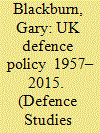

|
|
|
|
|
| Summary/Abstract |
This paper uses the strategic dimensions concept and content analysis of nine key defence white papers published between 1957 and 2010 to assess which factors most influence declaratory policy. The paper also notes that the development of defence policy has been accompanied by the “muddling through” vs. decisive choice debate which reflects the tensions within policy between the thesis of strategy and the antithesis of fiscal parsimony. The paper maintains that defence policy is ultimately contingent upon external threats and it is these, rather than the desire to economise, which are the key policy drivers. It concludes that this extrinsic factor will determine the outcome of the next SDSR and though this is not necessarily incongruent with the desire to economise, events may prove otherwise.
|
|
|
|
|
|
|
|
|
|
|
|
|
|
|
|
| 15 |
ID:
188216
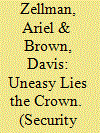

|
|
|
|
|
| Summary/Abstract |
Although often argued that religion should significantly influence international conflict, the empirical record is mixed. For every recurrent interreligious conflict, there are numerous examples of sustained interreligious cooperation. Conflict also frequently mars the oft-assumed peaceful relations between shared-religion states. We argue that religion is an important intervening factor in interstate dispute militarization, especially between internally threatened rivals. In mixed-religion dyads, conflict often follows oppression of cross-border coreligionists, whereas in shared-religion dyads, conflict occurs as one side disproportionately increases its official support for that religion. In both instances, dispute militarization is primarily an effort to undercut domestic competitors, whose challenge is augmented by external threats to leaders’ religious legitimacy. We test these propositions using new, long-term data on religious demography and state-religion policy, identifying rivalries via antecedent interstate territorial disputes. The findings largely confirm our hypotheses, substantially clarifying the conditions under which religion contributes to international militarized conflict.
|
|
|
|
|
|
|
|
|
|
|
|
|
|
|
|
|
|
|
|
|